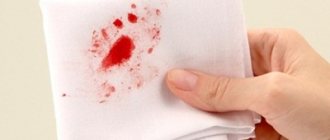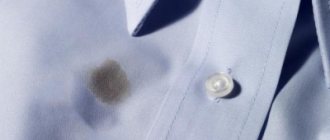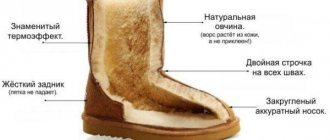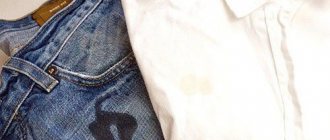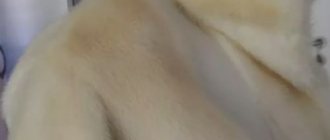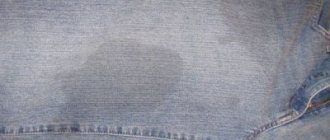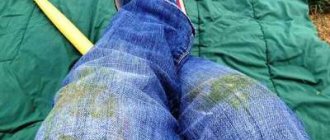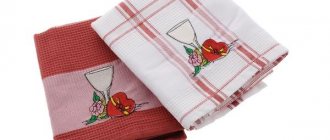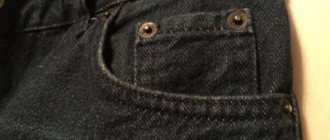Every wardrobe should have white socks as they fit into any style.
The problem is that they get dirty very quickly and after the first wash they lose their original fresh appearance. To prevent this, you need to wash them correctly.
In this article we will tell you how to easily and quickly wash white socks from black soles and dirt to snow-white at home.
Preparation for the process
Before you start washing your socks, you should prepare them:
- sorted by color and type of material;
- cleaned of dust and particles of dirt, for which they turn it inside out and shake it;
- select the appropriate detergent.
To improve the quality of subsequent washing, it is recommended to pre-soak light-colored socks.
For this, both regular washing powders for white laundry and solutions from improvised products are suitable:
- boric acid,
- vinegar,
- laundry soap,
- ammonia,
- peroxide.
The basin is half filled with warm water (no more than 30 °C) and the selected product is mixed into it . Then the laundry is immersed there and left for at least 3 hours (if it is very dirty, it can be longer). After this, you can start washing.
To correctly determine the method of washing socks, do not throw away the tags from new pairs. They usually contain important information about the product and care instructions from the manufacturer.
Method 1 - digestion
This is one of the most radical methods of whitening socks. It can be used for cotton products, but not for wool. How easy is it to wash socks with it? You should proceed like this:
- First you need to take a pan, fill it with water, add the juice of a quarter of a lemon to this water, as well as washing powder. Instead of the latter, you can take soap shavings.
- Now you need to put your socks in the water.
- Next, you will need to put the pan on the fire and bring its contents to a boil. After this, you should cook for another third of an hour.
After such a wash, you will need to additionally wash your socks by hand or in a machine. This method is quite labor-intensive, but it allows you to cope with even the most severe stains.
Washing in a washing machine
Wash socks in an automatic machine at a temperature of 40 to 60 °C . For cotton, synthetics and nylon, a temperature of 60 °C is suitable. Select a mode according to the type of fabric.
After putting the socks in the machine, pour washing powder, bleach or a home remedy into a special compartment.
It is recommended to add baking soda (2-3 tbsp) to the rinsing compartment. It not only promotes better rinsing of laundry, but also enhances the whitening effect.
After this, they start the machine and wait for the end of the cycle. It is advisable to throw several tennis balls into the drum along with the socks. Due to them, greater friction of the material will be created, which contributes to better cleaning.
"Lazy" solutions
In addition to the standard methods of “reanimating” light-colored hosiery, there are also unusual solutions. They are usually practiced by avid bachelors themselves and recommended to others.
Tennis balls
Peculiarities. It is enough to add a few balls to the drum of the washing machine along with the clothes, which will make it possible to create a good mechanical effect and quickly “beat” dirt from the fibers. However, first make sure that the balls themselves do not shed by keeping them in warm water.
Procedure
- Place socks in the washing machine drum.
- Place two or three tennis balls there.
- Turn on normal wash cycle.
Removing dirt manually
Washing socks by hand is considered delicate, so it should be done according to certain rules so that the socks do not lose their original shape.
How to proceed:
- Pre-soak the socks, which will reduce the washing time.
- Then pour fresh water into a basin slightly above room temperature.
- Start washing by creating friction of the material with your hands. At the same time, you should not be too zealous so as not to stretch or tear your socks.
When doing push-ups, do not twist your socks. It is enough to crumple them into a ball and lightly squeeze them in your hand.
Read more about hand washing white socks here.
Method 3 – turpentine
This product will help get rid of gray plaque and even traces of black soles. It is popularly considered one of the most effective. It should be used like this:
- First, you will need to prepare a special solution for washing. To do this, take a bucket of water (10 liters) and add three tablespoons of turpentine and regular washing powder to it.
- You need to put socks in the resulting composition and leave them there for a day.
The next day, you should remove the items from this solution and wash them in regular soapy water or a powder solution. After this procedure, the products will delight you with their impeccable whiteness.
How to bleach until snow-white and get rid of black soles?
Home remedies to help whiten socks have been successfully used for hand and machine washing. Here are some of the most productive recipes.
Soda
Instructions for action:
- Add 100 g of soda to clean water and soak socks in it for 15-20 minutes.
- Then they are placed in the machine drum.
- 4 tbsp are poured into the compartment intended for powder. l. soda
- Set the temperature to 40 °C and run a normal wash cycle.
Hydrogen peroxide
With the help of peroxide, you can quickly deal with even strong stains, provided that they are of biological origin (sweat, blood, grayness, yellowness).
The most effective will be 2 options:
Suitable for pure white socks.
For 3 liters of cool water, take 70-80 ml of hydrogen peroxide and the same amount of ammonia. Soak socks in this solution and rinse them after 12 hours, and then wash them in any way.- Acceptable for white socks with a pattern.
Squeeze a little toothpaste out of the tube into 80 ml of peroxide. The resulting mixture is used to treat contaminated areas and after 10-15 minutes, wash them off by rinsing in cold water.
Vinegar
This method can be used for socks made of natural fabrics, but it will not harm synthetics either.
Before the main wash, soak the stockings for 20-30 minutes in the following solution: add 2 large spoons of vinegar to 2-3 liters of water.
Bleaches
Nowadays you can find all kinds of bleaches on the shelves of hardware stores. They come in the form of powders, capsules and gels. They are also distinguished by composition: oxygen and optical.
The most popular are:
- Vanish;
- Ariel;
- BiMax;
- White;
- Clean Home;
- Beckmann.
The release form, volume and price of each are shown in the table:
| Name of washing and bleaching products | Volume | Cost, rub. |
| Ariel (gel) | 1.3 liters | 360 |
| BiMax (powder) | 3 kg | 530 |
| Vanish Oxy | 500 g | 440 |
| Clean Home | 1 l | 230 |
| Dr. Beckmann | 200 g | 215 |
| White | 1 l | From 17 to 30 |
When choosing a product, it is important to read the instructions , since it must be suitable for the material of the socks. It should also be marked “For white linen.”
Domestos or another bleach containing chlorine works well for black stains on socks from faded shoes. Just use it exclusively for washing cotton socks.
When working with chemical detergents, follow the instructions on the packaging. This applies to dosage and washing temperature.
Lemon juice
Lemon juice effectively removes grass and juice stains.
The recipe is as follows:
Squeeze the juice from one citrus and pour it into water (about 7 liters).- Soak hosiery in the solution for 3-4 hours.
- If stains remain after this, then additionally treat them with a slice of lemon and lightly rub the fabric.
- 20 minutes after such manipulations, the socks are sent to be washed.
If the socks have colored decorations, then the juice should be applied only to white fabric so that the elements do not become discolored.
Aspirin
When your white socks have become slightly faded and are no longer as snow-white as when they were new, you can resort to the following option:
- Grind 2 tablets of acetylsalicylic acid.
- Mix with a small amount of washing powder.
- Pour the mixture into the compartment of the automatic machine and start the wash in the standard mode.
You can put 3-4 tablets in the drum with laundry, and pour bleaching detergent into the tray. It is permissible to experiment with the dosage of the drug, which will not harm the laundry.
Do not use aspirin frequently when machine washing. This is due to the fact that it contains acid, which in large quantities can damage the machine.
In the case of hand washing, dissolve the same number of tablets in 3 liters of warm water and soak socks in this solution overnight. And in the morning they are washed.
Turpentine
Even extremely washed socks can be restored to their original whiteness with the help of turpentine.
For pre-soaking you will need 10-12 liters of water and 3 tbsp. l. turpentine _ Immerse the laundry in the solution and wait 3 hours.
Then wash in the machine as usual, but with an additional rinse.
Ammonia
Ammonia is available in almost every home medicine cabinet. So, to wash heavily soiled white socks, you need to dissolve it in water.
70-80 ml will be enough. The laundry is soaked in this solution for 2 hours and washed by hand or using a machine .
Boric acid
Before you start washing light-colored but dirty socks, soak them for 3 hours in the following product: dissolve boric acid in water (concentration 1:10). Since the acid eats away dirt, subsequent washing will be more effective.
Laundry soap
The surest way to remove stubborn stains on laundry, which our grandmothers used, is laundry soap.
Just thoroughly lather your socks with it and rinse in warm water. Similar actions are repeated 2-3 times. Then the socks are dried.
When to use boiling
Almost every person who wants to restore the whiteness of things will remember special household products. But you can use a proven method to whiten socks without harmful chemicals. We said earlier that using high temperatures can cause dirt to become embedded in the fibers of the fabric. Therefore, it is better to use boiling on things that have lost their whiteness, become gray or yellow.
You can wash white socks in a machine on the “Cotton 90” setting, and also try several methods of manual boiling:
- 1 way. Dissolve 5 tablespoons of soda and 2 ammonia in 5 liters of water. Dip things into this solution and cook them for about 20-30 minutes.
- Method 2. Place chopped lemon on a pot of water and boil the hosiery, previously washed by hand or in a machine, for 15-20 minutes.
Features depending on the fabric (cotton, synthetics, wool)
To understand how to wash socks, you need to decide on the type of material from which they are made. It's easier to find out by reading the tag. If this is not possible, then they are determined by touch.
Thus, woolen and synthetic products require a more careful approach than cotton ones . Soak them briefly and wash them at 40°C, preferably by hand. For synthetics it is better to take washing powder, for wool - gel.
To prevent pilling from appearing on woolen socks, they should be washed in a machine with the addition of conditioner and on a delicate cycle.
Cotton products can be boiled .
To do this, add washing powder and a couple of lemon slices to boiling water. Then put the socks there and boil them for a quarter of an hour. Afterwards, all that remains is rinsing.
Features of caring for socks made of different materials
Like any clothing, socks can contain many components that, if not properly cared for, can quickly become unusable. Therefore, in order for terry socks or synthetic stockings not to lose their “marketable” appearance, you need to know how to properly care for them, depending on the type of material.
If the socks are made of cotton
Clothing made from natural cotton, bamboo or linen can withstand high temperatures well. This means that such products will withstand boiling and exposure to aggressive bleaches. That is, washing cotton socks is not difficult.
Useful tips
Here are some useful tips on the topic:
white socks are washed after a single wear;- do not wear white socks if the insoles are dark;
- carefully take care of the internal condition of the shoes, systematically cleaning them from dust and all kinds of debris;
- use deodorants for feet so that they sweat less and do not leave yellow spots on socks;
- Do not wash wool socks in hot water, otherwise they will shrink.
Additional recommendations
When washing socks you should not:
- Wash linen and towels at the same time. In conditions of the basin, this is not hygienic, because it is difficult to rinse the terry cloth thoroughly, and it is easy to carry residual dirt onto the skin or into the eyes. In addition, washing conditions for towels are more stringent than for socks.
- If your feet suffer from sweating or fungus, it is recommended to soak your socks in a relatively strong solution of citric acid or other disinfectant before washing.
- For socks, double rinsing is advisable: if clumps of powder or bleach remain between the fibers, the soles will get dirty many times faster, and skin irritation and allergies are possible.
- It is highly recommended not to boil socks. Even durable cotton socks contain elastane thread - it will lose its properties and the socks will not stay on the foot. And the cotton fabric will most likely shrink, and the laundry will become small and slide off the heel.
Maintaining or restoring the whiteness of socks is both a difficult and simple task. As practice shows, it is enough to change socks as soon as a gray coating appears on the soles to preserve the shine of the color. And to avoid pilling and extend the life of your socks, you need to wash them carefully: in a net if in the car, and after soaking, without effort, if on your hands. Then the linen will be white and attractive for a long time.
Method 6 – vinegar
How to quickly wash items using ordinary household products? You can use a solution based on ordinary table vinegar for a similar purpose. They use it like this: take slightly heated water (preferably it should have a temperature of about 40 degrees), in total you will need a liter of such water for 1-2 pairs of socks. Add a spoonful of vinegar to this water and leave things in the resulting solution for just half an hour.
After this, you will need to wash the products well and evaluate their condition. If stains or yellowing remain, you will need to try a stronger product. This option will work well only on minor stains formed during the first or second wear of the product.
Advantages of the method
Baking soda has its advantages over traditional bleaching agents:
- Does not contain fragrances or harmful chemicals. Therefore, it does not cause allergies and is ideal for washing children's clothes.
- This is a universal product that can be used for different materials.
- Availability and low cost.
- Perfectly complements washing powder.
- Helps protect washing machine parts from scale.
- It has a gentle effect on fabrics compared to classic bleaches.
- Is an excellent conditioner.
How not to spoil things
| Wear-safe ingredients | ||
| Cotton | Synthetic | Woolen |
|
|
|
Risk of discoloration. The fabric may become discolored due to the addition of hydrogen peroxide to the homemade detergent. To avoid this, you should strictly follow the proportions specified in the recipe, or completely abandon its use for washing colored items.
Method 5 - ammonia
How can you easily wash gray or yellowed items? Use a product based on peroxide and ammonia for this purpose. Working with it is very simple: you need to take peroxide and ammonia in a 2:1 ratio, mix these components well and pour the resulting homemade bleach onto your socks. Next, you should leave the products to dry for half an hour, after which you just need to wash them by hand.
Important:
After such bleaching, do not forget to hang your socks to dry in a place that is very well ventilated. Otherwise, you will not be able to get rid of that specific smell that usually remains after ammonia.
You can also use ammonia solution as a stain remover without peroxide. To do this, you need to take no more than a liter of ordinary cool water, add two spoons of this product to it and leave things in this solution for a couple of hours. This product will work very well if the socks have not gotten very dirty: it will help get rid of dirt and will prevent the appearance of yellowness after prolonged wear.
Method 8 - soda
White socks can be saved with just ordinary baking soda. For this procedure you will need only 200 grams of this product. You will need to work with it like this: you should put the items in the machine, add the soda itself to the softener compartment, and otherwise wash the items as usual. A normal cycle or even an express wash will be enough to return the items to their original whiteness.
Video: how to bleach with soda?
Advice:
For this method to work better, use it as soon as you notice the first dirt on the products. Remember: the longer you delay washing, the higher the chances that this product will not help you at all.
What to do if your socks are dyed?
White marks may become colored after:
- Washing with brightly faded clothes (mostly cotton and wool). Increased water temperature helps remove color.
- Wear them with dark shoes, especially closed ones.
- In such cases, it is necessary to bleach the hosiery with chlorine-containing substances, then rinse well. If this does not help, you can wash light-colored socks from black soles or faded colors using one of the methods suggested above. Boric acid or peroxide is best.
